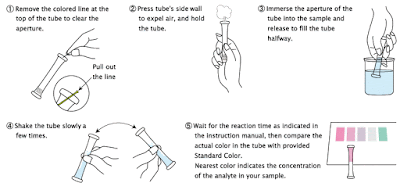Rapid PACKTEST is commonly known as PACKTEST. This test is a simple onsite method of testing water quality which produces amazing results in a split of a second. It does not require complicated analytical techniques to determine the quality of water. Concentration of heavy metals, precious metals and any other elements and compounds in the water are detected using this method. pH of water can also be determined using this method. Water in this case can be a flowing creek,settling ponds, pool beside vats or heap leach pads, mine pits etc.
 |
PACKTEST Results for Pihema Creek,
Morobe Province. Cyanide Detected
(Dark-blue).
|
It is recommended
that Pact Test should be practiced by all government regulators in the
extractive industries especially in the Mining and petroleum industry. This
will greatly help during statutory inspections which can give results instantly
onsite rather than waiting for results in the laboratory after few weeks or
months. This will also be a alert for the industry to treat waste water
effectively or improve on their waste water treatments and monitoring
techniques.
The process and the
setup of the testing method are outlined below.
Sampling Procedure for PACKTEST
1.
Fetch
water in container and filter the water using syringe and 0.45µm filter
to filter water sample and pour filtered water sample into a clear mini
cylinder.
2.
Remove the colored line at the top of the tube
to clear the aperture.
3.
Press
tube's sidewall to expel air, and hold the tube.
4.
Immerse
the aperture of the tube into the water sample in the mini cylinder and release
to fill the tube halfway.
5.
Shake
the tube slowly for few seconds.
6.
Wait
for the reaction time as indicated in the instruction manual, and then compare
the actual color in the tube with provided Standard Color. The nearest color
indicates the concentration value (mg/L = ppm) of the analyte in your sample.
Note: Cyanide is tested differently. Before the above procedure is applied,
first of all dissolve the mixing reagent into the filtered water in a small enclosed
translucent cube of about 2cm x 2cm x 1.5cm in size. Finally immerse the
cyanide reagent into the solution and release to fill up the tube. Shake the
tube and record the reading after 8 minutes.
The reaction times for
each element or compound varies from seconds to minutes. Reaction time for
cyanide takes longer than any other elements or compounds. It could be other
elements or compounds as well but during the tests conducted by the reporter
indicated that cyanide took longer than other elements.
It is recommended that
PACKTEST should be conducted on site. It would be a bad practice if sample is
taken from a different spot and date and tested on different date and location
as the results would not represent the sample location and time.
If you do then be aware to note the results and anticipate error in the
readings recorded.
Other Equipment for
testing water quality includes but not limited to pH meter, Turbidity Meter. pH
meter is for measuring the pH level of water
and also measure the temperature of water. Turbidity meter measures
turbidity of water and also temperature and metal conductivity in the water.













0 comments:
Post a Comment